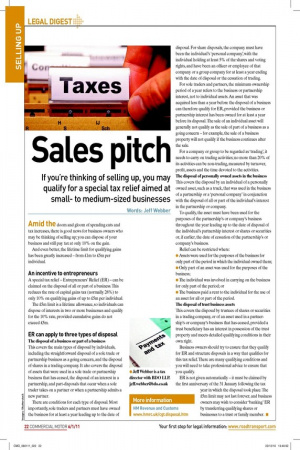Sales pitch
Page 19

If you've noticed an error in this article please click here to report it so we can fix it.
If you’re thinking of selling up, you may qualify for a special tax relief aimed at smallto medium-sized businesses
Amid the doom and gloom of spending cuts and tax increases, there is good news for business owners who may be thinking of selling up; you can dispose of your business and still pay tax at only 10% on the gain.
And even better, the lifetime limit for qualifying gains has been greatly increased – from £1m to £5m per individual.
An incentive to entrepreneurs
A special tax relief – Entrepreneurs’ Relief (ER) – can be claimed on the disposal of all or part of a business. This reduces the rate of capital gains tax (normally 28%) to only 10% on qualifying gains of up to £5m per individual.
The £5m limit is a lifetime allowance, so individuals can dispose of interests in two or more businesses and qualify for the 10% rate, provided cumulative gains do not exceed £5m.
ER can apply to three types of disposal
The disposal of a business or part of a business This covers the main types of disposal by individuals, including the straightforward disposal of a sole trade or partnership business as a going concern, and the disposal of shares in a trading company. It also covers the disposal of assets that were used in a sole trade or partnership business that has ceased, the disposal of an interest in a partnership, and part-disposals that occur when a sole trader takes on a partner or when a partnership admits a new partner.
There are conditions for each type of disposal. Most importantly, sole traders and partners must have owned the business for at least a year leading up to the date of disposal. For share disposals, the company must have been the individual’s ‘personal company’, with the individual holding at least 5% of the shares and voting rights, and have been an oficer or employee of that company or a group company for at least a year ending with the date of disposal or the cessation of trading.
For sole traders and partners, the minimum ownership period of a year refers to the business or partnership interest, not to individual assets. An asset that was acquired less than a year before the disposal of a business can therefore qualify for ER, provided the business or partnership interest has been owned for at least a year before its disposal. The sale of an individual asset will generally not qualify as the sale of part of a business as a going concern – for example, the sale of a business property will not qualify if the business continues after the sale.
For a company or group to be regarded as ‘trading’, it needs to carry on trading activities; no more than 20% of its activities can be non-trading, measured by turnover, proit, assets and the time devoted to the activities. The disposal of personally owned assets in the business This covers the disposal by an individual of a personally owned asset, such as a truck, that was used in the business of a partnership or a ‘personal company’ in conjunction with the disposal of all or part of the individual’s interest in the partnership or company.
To qualify, the asset must have been used for the purposes of the partnership’s or company’s business throughout the year leading up to the date of disposal of the individual’s partnership interest or shares or securities or, if earlier, the date of cessation of the partnership’s or company’s business.
Relief can be restricted where: ● Assets were used for the purposes of the business for only part of the period in which the individual owned them; ● Only part of an asset was used for the purposes of the business; ● The individual was involved in carrying on the business for only part of the period; or ● The business paid a rent to the individual for the use of an asset for all or part of the period.
The disposal of trust business assets This covers the disposal by trustees of shares or securities in a trading company, or of an asset used in a partnership’s or company’s business that has ceased, provided a trust beneiciary has an interest in possession of the trust property and meets detailed qualifying conditions in their own right.
Business owners should try to ensure that they qualify for ER and structure disposals in a way that qualiies for this tax relief. There are many qualifying conditions and you will need to take professional advice to ensure that you qualify.
ER is not given automatically – it must be claimed by the irst anniversary of the 31 January following the tax
year in which the disposal took place. The £5m limit may not last forever, and business owners may wish to consider ‘banking’ ER by transferring qualifying shares or businesses to a trust or family member. ■














































